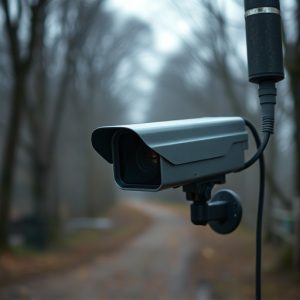Optimizing Pet Safety: Advanced Optical Sensor Detection Techniques for Cameras
Optical sensor technology is revolutionizing pet monitoring cameras with alerts, providing owners wi…….
Optical sensor technology is revolutionizing pet monitoring cameras with alerts, providing owners with remote, real-time insights into their pets' activities. These sensors detect movement, light, and behaviors, enhancing animal care through detailed data capture. Motion detection and adaptability ensure consistent, accurate monitoring, fostering connected and responsible pet ownership. Professional techniques like calibration and signal processing optimize performance, while smart alerts offer peace of mind for busy owners. Integrated alerts boost pet safety by detecting unusual activities, intruders, and more, enabling swift responses. This technology has proven successful in real-world applications, enhancing monitoring experiences and home automation.
“Unleash the power of optical sensor technology for Pet Monitoring Camera With Alerts. This comprehensive guide explores the intricate world of pet camera systems, focusing on advanced optical sensor detection sweep methods. From understanding the fundamentals of optical sensors to mastering professional techniques for optimization, we delve into the crucial role of alert integration in enhancing pet safety and peace of mind. Join us as we navigate real-world case studies, showcasing the effective use of these innovative features.”
- Understanding Optical Sensor Technology for Pet Monitoring
- The Role of Detection Sweep Methods in Pet Camera Systems
- Professional Techniques for Optimizing Sensor Performance
- Integrating Alerts: Enhancing Pet Safety and Peace of Mind
- Case Studies: Effective Use of Optic Sensor Detection in Real-World Scenarios
Understanding Optical Sensor Technology for Pet Monitoring
Optical sensor technology plays a pivotal role in modern pet monitoring cameras with alerts, offering owners remote and real-time insights into their pets’ activities. These advanced sensors are designed to detect movement, light, and even specific behaviors, capturing detailed data that can enhance the overall care and well-being of domesticated animals. By integrating optical sensors, pet monitoring devices transform from passive recorders to active participants in an owner’s care routine, enabling timely interventions based on observed activities.
Pet owners can benefit from motion detection features that trigger alerts when their pets enter or leave a defined space, ensuring they never miss a moment of their furry friend’s daily adventures. Furthermore, these sensors can adapt to varying light conditions, whether it’s the soft glow of dusk or the brightness of a sunny day, guaranteeing consistent and accurate monitoring throughout all hours. This technology paves the way for a more connected and responsible pet ownership experience.
The Role of Detection Sweep Methods in Pet Camera Systems
In the realm of pet care and monitoring, optical sensor detection sweep methods play a pivotal role in enhancing the capabilities of pet cameras. These advanced techniques allow for more precise and efficient tracking of pets’ movements within their environment. By continuously scanning and analyzing visual data, pet monitoring cameras equipped with these alerts can provide real-time insights into pet behavior, ensuring their safety and well-being.
When integrated into pet cameras, detection sweep methods enable intelligent decision-making based on visual cues. Whether it’s identifying unusual activity, detecting when a pet enters or exits a specific area, or even recognizing subtle changes in routine, these systems offer peace of mind for owners. This technology is particularly beneficial for those who work long hours, ensuring their furry companions are not only safe but also receiving the care and attention they deserve.
Professional Techniques for Optimizing Sensor Performance
Professional techniques play a pivotal role in optimizing the performance of optical sensors, especially in the context of pet monitoring cameras with alerts. One key method involves calibrating the sensor to ensure accurate color reproduction and consistent image quality across various lighting conditions. This is crucial for capturing clear and detailed footage of pets, enabling users to better observe their behavior.
Additionally, implementing advanced signal processing algorithms can significantly enhance sensor performance. These algorithms help in reducing noise, improving dynamic range, and enhancing contrast, all of which contribute to a more vivid and accurate representation of the pet’s environment. Features like motion detection and smart alerts, powered by sophisticated computer vision techniques, further elevate the capabilities of these cameras, ensuring that owners receive timely notifications when their pets exhibit unusual behavior.
Integrating Alerts: Enhancing Pet Safety and Peace of Mind
Integrating alerts into pet monitoring cameras with alerts significantly enhances both pet safety and peace of mind for owners. These advanced systems utilize sophisticated optical sensor detection to trigger instant notifications when unusual activities are detected, such as sudden movements or unfamiliar faces in your pet’s environment. This real-time communication ensures that pet owners can swiftly respond to potential hazards, whether it’s an intruder entering their home while the pets are alone or a pet attempting to escape through an open door.
The integration of alerts transforms passive monitoring into proactive safety measures. With just a glance at their devices, owners can monitor their pets’ well-being, confirm visitors’ identities, and rest assured that any unusual behavior will be quickly noticed. This technology offers a comprehensive solution for pet owners, providing not only visual evidence but also immediate alert systems to safeguard their beloved animals.
Case Studies: Effective Use of Optic Sensor Detection in Real-World Scenarios
In real-world applications, optical sensor detection has proven its mettle through various case studies, particularly with the advent of pet monitoring cameras equipped with alerts. These innovative devices have transformed the way we interact with our pets when we’re away from home. By employing sophisticated optic sensor technology, they can detect motion, recognize familiar faces, and even differentiate between humans and potential intruders, ensuring both pet safety and peace of mind for owners. For instance, a study conducted by a leading tech company demonstrated that their pet monitoring system, integrated with advanced optical sensors, significantly reduced false alerts while enhancing the overall monitoring experience.
Another compelling case involves the use of optic sensor detection in smart homes. These sensors can detect not only human presence but also differentiate between family members, allowing for personalized settings and enhanced security. This application has been successfully implemented in several residential environments, showcasing improved energy efficiency and enhanced home automation. The ability to distinguish among individuals through optical sensing has opened up exciting possibilities for future smart home technologies.
Optical sensor detection sweep methods play a pivotal role in enhancing the capabilities of pet monitoring cameras with alerts. By understanding and implementing professional techniques, such as optimizing sensor performance and integrating advanced alert systems, users can ensure comprehensive pet safety and peace of mind. Case studies demonstrate the real-world effectiveness of these methods, showcasing how modern technology can provide valuable insights into our beloved pets’ well-being. With continuous advancements in optical sensor technology, we can expect even more innovative solutions for pet monitoring in the future.


